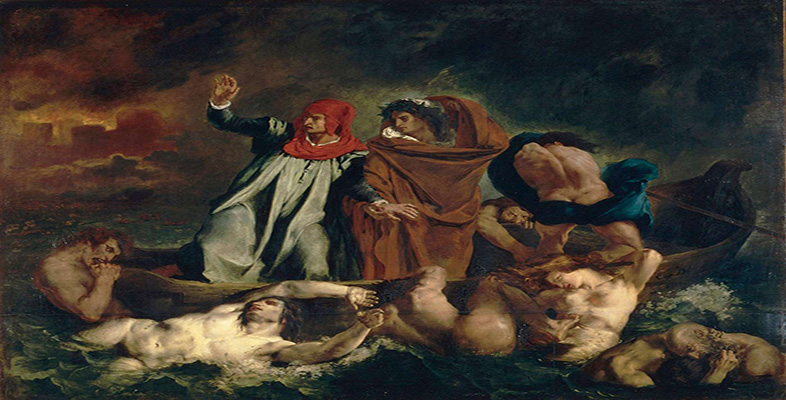3.5 The Barque of Dante – innovation within tradition
The urge to depart from tradition, without abandoning classicism, is apparent in Delacroix’s earliest Salon exhibits. Displayed there in 1822, some years before the Sardanapalus, The Barque of Dante (see Plate 16) depicts an episode from the Inferno, a poem written by the medieval Italian poet Dante. The poet imagines being rowed, in the company of the Roman poet Virgil, across the lake surrounding the infernal city of Dis, which is in flames in the background. Sinners are clinging to and trying to climb into the boat. The work, not commissioned and on a subject of Delacroix’s own choice, was bought by the government for its museum of modern art, the Musée du Luxembourg. Although it does not conform to the practices of Neoclassicism, its use of tonal effects and nudes is very similar to that of Michelangelo, an alternative classical source. It lies recognisably within the tradition of grand history painting, and the composition (with symmetrical, central figures surrounded by a balanced arrangement of other figures) is classical. As we saw earlier, Gros regarded it as a ‘polished Rubens’. Its use of colour is novel but fairly restrained. There is a mass of grey enlivened by skilfully placed patches of green, red and blue. Influenced by Rubens’s Landing of Maria de’ Medici at Marseilles (Plate 6), the droplets of water on the nudes’ bodies show all the colours of the spectrum. (The work was retouched in 1859, however, so we must take care in our assumptions about what was in the ‘original’.) Rubens had certainly established a tradition of dramatic seascapes (see Plate 19, The Miracle of St Walburga). Charles Delécluze found Delacroix’s painting as a whole a ‘real mess’ (quoted in Jobert, 1998, p.69), but admired the drawing and colour of the main figures. In a review of the 1822 Salon, however, Adolphe Thiers saw the work as evidence of Delacroix’s genius: ‘I find this power wild, ardent but natural, which effortlessly yields to its own force … I do not think I am wrong: M. Delacroix has the gift of genius’ (quoted in Jobert, 1998, p.69). With his first Salon, Delacroix thus gained a reputation as an innovator who worked within, rather than overthrowing, tradition. The choice of subject was novel for a history painter and showed a departure from the usual repertoire of topics from classical antiquity and national history.
Click to see Plate 19: Nicolas Poussin Peter Paul Rubens, The Miracle of St Walburga [Tip: hold Ctrl and click a link to open it in a new tab. (Hide tip)]
